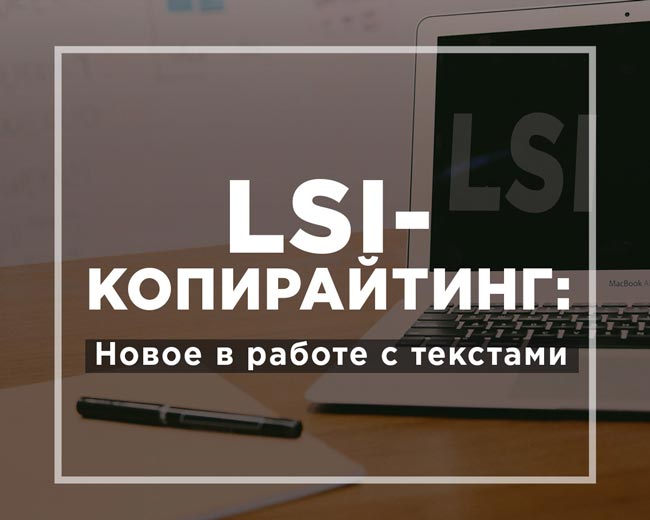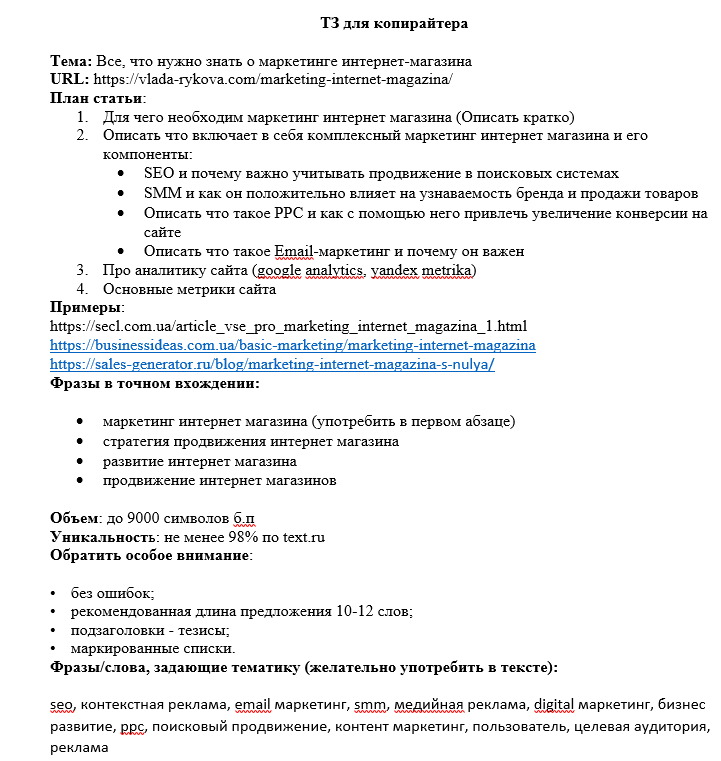SEO- и LSI-копирайтинг: особенности, отличия и инструкция для создания ТЗ для LSI-статьи
Термин SEO-копирайтинг, как и само понятие, так и необходимость в написании подобных текстов, отходит в прошлое. Вместо него все больше востребован LSI-копирайтинг.
SEO-копирайтинг или райтинг – написание информационных текстов для сайтов, которые были бы интересны читателям и отвечали требованиям поисковых систем.
LSI-копирайтинг (latent semantic indexing с англ. яз. «латентное семантическое индексирование») – методика написания текстов, которая объединяет ожидания пользователей с ожиданиями поисковых систем. При их создании широко используют:
- синонимы;
- слова, сопутствующие ключевому запросу: терминология, сленг, слова, задающие тематику;
- глубокую проработку содержания и смысла текста.
Отличие LSI-копирайтинга от SEO-копирайтинга
| LSI-копирайтинг | SEO-копирайтинг |
| Семантическая вариативность | Ключевые слова |
| Соответствие контексту | Плотность ключевых слов |
| Экспертность (достоверность информации) | Расположение ключевых слов |
| Добавочная ценность | Виды вхождений (точное, разбавленное) |
| Отказы |
В SEO-копирайтинге на первом месте стоят ключевые слова, которые можно подобрать с помощью специальных сервисов или получить в качестве одного из пунктов в ТЗ от SEO-специалиста. В отличие от SEO-копирайтинга LSI-копирайтинг, направлен на удовлетворение максимальных ожиданий читателя. Там более актуальна семантическая вариативность. Что это значит? К примеру, потенциальный покупатель вводит запрос «купить красные сапоги», поэтому в поисковой выдаче он должен получить текст, в котором будут описаны красные сапоги, а также обязательно предусмотрена возможность покупки данного товара.
Что касается плотности ключевых слов, этот термин специалисты по поисковому продвижению сейчас стараются не использовать даже при оформлении ТЗ для копирайтера. Вместо этого на первый план выступает понятие соответствия контексту, то есть наличие в готовом тексте необходимого дополнительного набора слов по тематике, которые также используются пользователями при поиске информации в интернете.
В расположении ключевых слов тоже произошли изменения. Раньше большую значимость имело наличие ключей в основном заголовке, в первом по счету подзаголовке, в начале текста и т.д. В LSI-копирайтинге такой концентрации на четком расположении ключей нет. В первую очередь важна достоверность информации, которую предлагают потенциальному пользователю, ее уникальность и полнота.
Чтобы определить добавочную ценность текста на этапе его создания, необходимо перед началом работы над контентом изучить ТОП-10 похожих статей на конкурирующих сайтах, которые предлагает поисковая система Google или Yandex по интересующей тематике. На их основе будет легче составить приблизительный план. Вам необходимо будет проработать тему так, чтобы ваша статья была наиболее полной, отвечающей всем запросам пользователей. Особое внимание необходимо уделить заголовку, подзаголовкам, а также дополнительной информации: таблицам, графикам, картинкам, спискам, инфографике и пр.
Виды вхождений также принимают во внимание при написании качественного контента. Но поисковые системы уже используют алгоритмы по отслеживанию чрезмерного использования точных и разбавленных вхождений ключевых слов. Это привело к тому, что те сайты, которые чрезмерно насыщены ключами, попали под фильтры или выбыли из поиска. Именно поэтому в LSI-копирайтинге отдают предпочтение использованию синонимов.
Что касается пункта отказы, то этот показатель отслеживает SEO-специалист через панели вебмастера или системы аналитики. Что подразумевает под собой данное понятие? Если пользователь поисковой системы Yandex находится на сайте менее 15 секунд (для Google – просмотр только одной страницы), система расценивает это как нерелевантность текста запросу или его бесполезность. Если процент отказов слишком высок, контент считается не отвечающим ожиданиям пользователя и страница снижается в поисковой выдаче. В этом случае необходимо проработать всю страницу, включая контент-составляющую и юзабилити.
Виды LSI-ключей
Ключи для LSI-статей бывают трех основных видов:
- SEO-ключи – стандартный набор ключевых слов, подбираемый под тематику статьи точно так же, как и для SEO-статей.
- Синонимичные (sLSI) – ключи с синонимами основных SEO-запросов. Например, синонимом ключевого слова «авто из Китая» будет «китайское авто».
- Релевантные (rLSI) – это слова из окружения главного ключа, так называемые дополняющие ключевые слова, а также другие ключи, имеющие прямое отношение к теме статьи. К ним относятся сленг, узкая терминология и т.п. По ним поисковая система определяет насколько хорошо раскрыта тема текста. Например, релевантными словами к ключу «авто из Китая» будут «официально», «недорогие», «мотор», «двигатель», «высокотехнологичные» и т.п.
Признаки качественного текста для поисковых систем
Сейчас объемные тексты так же популярны, как и короткие. Длина статьи для вывода страницы на верхние строчки ПС определяется следующим образом: вычисляем среднее арифметическое на основе текстов, которые составляют ТОП-10 в выдаче поисковой системы по интересующей тематике.
Другими важными признаками хорошего текста, по мнению поисковых систем, являются:
- четкая структура: подзаголовки, списки, абзацы;
- уникальность;
- тематическая лексика, большое количество синонимов;
- использование слов, задающих тематику;
- полезность и новизна;
- простота изложения;
- ритмика текста;
- плотность ключевых слов и пассажей: равномерное распределение, отсутствие тавтологии;
- экспертная информация;
- отсутствие ошибок.
Мета-теги для страниц на сайте
Хотя SEO-тексты постепенно отходят в прошлое, их наличие на сайтах может помочь в улучшении его позиций в поисковой выдаче. При этом важно не только хорошо написать сам текст, но и правильно проработать мета-теги. Для них действуют следующие правила:
- Ключевое слово должно быть в <Title>.
- Уникальный, «продающий» <Description> с ключевым словом.
- Правильная структура страницы: H1 – единственный, использование H2, H3, H4 для подзаголовков.
- Ключевые слова в alt и title картинок.
Все эти пункты может прописать как SEO-специалист, так и автор статьи, если он знаком с основами продвижения сайтов. Делать это необходимо основываясь на изучении страниц конкурентов. При этом не нужно как-то выделять ключевые слова. Это даже вредно, так как может привести к попаданию под фильтры поисковых систем. При этом использование средств для выделения в тексте не является запретным. Просто лучше курсивом или полужирным выделять какие-то термины или важные мысли, а не отдельные ключевые слова и фразы.
Примерная инструкция по созданию ТЗ для написания LSI-текста на сайт
На примере рассмотрим каким должно быть «идеальное» техническое задание для написания LSI-текста на сайт. Его цель заключается в том, чтобы автор, приступая к написанию текста, не тратил дополнительно время на работу с сервисами для поиска ключевых и тематических слов, а также определения рамок, которые помогут вывести страницу в ТОП поисковых систем. Определением важных параметров обычно занимается SEO-специалист, ответственный за продвижение сайта. Для этого он выполняет:
- Подбор ключевых слов через сервис SeRanking, Планировщик ключевых слов от Google или Serpstat. Некоторые предпочитают использовать программу Key Collector.
- Подбор слов задающих тематику через Rush Analitycs, бесплатный инструмент Александра Арсёнкина, «Пиксель Тулс», «похожие фразы» Serpstat или другого платного сервиса. Также для этого подходят поисковые автоматические подсказки Яндекса и Google.
- Проработку текстов из ТОПа выдачи на определение допустимого процента водности, заспамленности, рекомендованной длины текста. Как правило, нормальной считается водность до 15 %, заспамленность от 30 % до 60%. Но в зависимости от тематики эти показатели могут варьироваться в большую или меньшую сторону. Длина статьи определяется средним арифметическим, исходя из контента тех страниц, которые уже находятся в ТОПе.
На основании проработанной информации составляется ТЗ для автора. Некоторые SEO-специалисты не указывают никаких рамок и ключевых слов, предпочитая получить экспертный материал, который впоследствии «затачивают» под требования поисковых систем. Другие, наоборот, предпочитают сразу озвучить все требования к тексту, чтобы минимизировать количество доработок.
Проверка текста перед сдачей заказчику или размещением на сайте
- Проверка на грамматические и орфографические ошибки. С этим хорошо справляется gramota.ru и Орфограммка.
- Проверка на уникальность текста через сервисы content-watch.ru, text.ru или другие аналогичные.
- SEO-анализ текста и прогон через лемматизатор. Первое можно выполнить на сайте биржи Адвего, istio.com и т.п. Удобные лемматизаторы у Арсёнкина.
- Оценку читабельности через ru.readability.io, pr-cy.ru, Главред, Тургенев . Каждый использует те инструменты, которые ему наиболее близки, так как в целом оценка любого текста – субъективна. Сервисы же помогают посмотреть на контент наиболее приближенным на поисковые системы взглядом.
- Сравнение текстов на схожесть, если необходимо быстро подготовить и загрузить несколько текстов на одну или близкую тему. Особенно актуально в том случае, если их написанием занимается один и тот же автор.
- После получения результатов проверок текст дорабатывается на основании рекомендаций используемых сервисов.
Особенностью LSI-копирайтинга также можно назвать то, что процесс создания текстов по этому принципу практически беспрерывен. Через 2-3 месяца после публикации контента на сайте, следует провести анализ выдачи сайта по запросам, по которым на страницу попадают пользователи. Это даст дополнительные ключевые слова и идеи для улучшения статьи. Подобные апгрейды рекомендуется делать раз в полгода или чаще.
Эксперт в области интернет-маркетинга. Руководитель маркетингового агентства MAVR.
Бизнес-степень «Мастер делового администрирования» (MBA).



